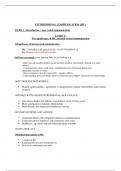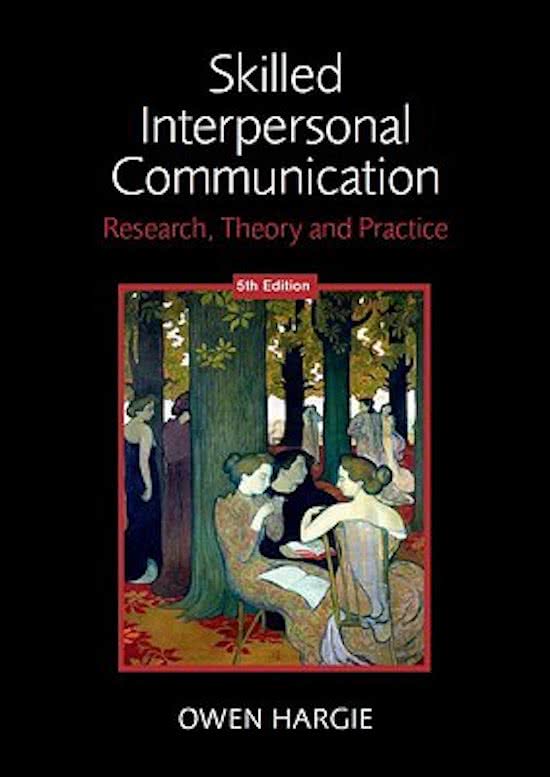INTERPERSONAL COMMUNICATION (IPC)
WEEK 1 ;Introduction + non verbal communication
Lecture 1:
The significance of IPC and non-verbal communication
Significance of interpersonal communication
- IPC - Embedded in all aspects of life – it is FUNDAMENTAL
Eg; Making contact with other people
Still face experiment: mom ignoring baby by just looking at it
- Baby uses all possible abilities to get mothers attention (movement, smiling..) to make
contact.
- Communication starts really early - fundamental need of humans Interaction
Immediate reaction of infant
- Stress responses when it’s impossible - negative effects
- Understanding processes helps improve communication Higher satisfaction of relationships
IPC PROCESS DETERMINES;
Mutual understanding – agreement vs disagreement, mutual relationship, achievement
of goals
PEOPLE WITH GOOD INTERPERSONAL SKILLS HAVE;
Less stress, higher self-efficacy (can achieve more of their goals)
More satisfaction in intimate relationships
More friends, less depression/loneliness/ anxiety
INTERVENTIONS AND ADVICE;
Communications with companies (internal communication)
Communication companies with costumers (web care)
Healthcare; eg; doctor patient communication, e-health
OWN EFFICACY
Fundamental aspects of IPC
A model of IPC
Interpretations and miss interpretations
How do we understand each other
,Source-Receiver Model (linear) –
(related to bowling analogy – 1
person has a message using a certain
channel by which he sends a message
encodes it and then its decoded by
recipient)
sending message to recipient
responses immediately influence us
Ex: breaking up with boyfriend
Outside influences influence on
delivery (not wanting to hurt
someone)
Missing; non-verbal behaviour +
Response of reipient/ interactivity + Interpretation of message (and
misinterpretation)
transactional model (circular) –
Circle is an ongoing process = immediate response +
creating mutual meaning
Transacactive process what one person does changes
things in the other person
Collaboration adapting messages to other (between 2 or
more people)
Noise phycological
Conversation;
Transactive
Joint action
Interdependence, reciprocity (what one person dose affects the other)
Interpretations about meanings and intentions on both sides
Much is left unsaid (due to multiple perspectives)
Theory of coordinated management of meaning Interdependent on
eachother (communication partners)
Language is ambiguous; (Derek Bentley – murder “let him have it” – shoot him or
give him the gun) – sentence can be 2 things
Multiple meanings - positive or negative, sarcastic (litterally positive, meaning negative)
Eg;you probably had a fantastic time with klass today ? – sarcastic/ ironic
interpretations also play a role on conversation + relationship level
,Misinterpretations
Sexual over perception bias – tendency to believe others are more sexually interested in you then
they actually are
(Unintentional) touch/ eye contact ( non - verbal behaviour)
- mainly happens with men Overthinking someone’s intentions
HOW DO WE UNDERSTAND EACH OTHER?
It is a common misperception that language use has primarily to do with words and what
they mean (it dose not). It has primarily to do with people and what they mean = essentially
about speakers intentions.
-How we come to understand; (important IPC topics)
>common ground/ grounding
>perspective taking (own vs others)
>egocentrism vs the third story
>self disclosure – ( do we disclose or keep to self)
>questioning, reflecting, listening
how do we understand each other’s intentions;
o influence of context
o influence of behaviour of conversation partners
o influence of the medium
Context & mutual understanding
the situation we find ourselves in when having a interaction (lecture room, at night, day..)
Eg; touching bum example – is it appropriate + 11am coffee vs 1am club
Understand the situation
- context dimensions;
1. Set induction How you open an interaction sets the tone for the rest of it - determined at
the start of it Physical environment
2.phisical environment
3.temporal factors - Timing of message (2 am vs 2pm)
4.social phycological factors
interpersonal relationship (roles, status, history)
communication history (common ground)
5.Culture – touching eachother
6.Type of situation and expectancies
Scripts - event schemas
Eg; first date script (describing first date script / expectations)
Behaviour and mutual understanding;
Behavior of conversation partners determines the course of conversations Interdependence!
Important topics in IPC:
Nonverbal behavior: haptics, kinesics, posture, gaze etc.
, (Non) verbal dominance: turn taking (interrupting, silences)
Questioning (open vs closed, leading, probing)
Reflecting(on what other person says), reinforcement
Listening
Response styles: assertiveness vs. aggression
the medium and mutual understanding;
Medium determines which (interactive) behaviour is possible, which signals go back and forth.
Important topics in IPC:
Constraints and affordances of different media.
Media richness
Social presence
non verbal communication
Negotiations in relationships
- Non verbal mimicry vs complimantary
- Hiarchy/ status position
purposes of non-verbal communication;
Replacing, complementen and modifying verbal communication
- Regulating conversations
- Expressing emotions and interpersonal attitudes
- Negotiating relationships (idea of transactive model(we constantly influence each
other in interactions)
- Conveying personal and social identity
- Contextualizing interaction
negotiating relationships;
-non conscious influence;
Facial mimicry: imitation of facial expression (Dimberg, 1982; Meltzoff &
Moore, 1979, 1983; O’Toole & Dubin, 1968; Provine, 1986; Vaughan &
Lanzetta, 1980; Zajonc et al., 1982, 1987)
Speech: linguistic style matching (Bock, 1986, 1989; Levelt &
Kelter, 1982; Prinz, 1990; Ireland et al., 2010)
Emotion/mood contagion (Bavelas et al., 1986, 1987; Hatfield et al.,
1994; Neumann & Strack, 2000; Zajonc et al., 1987)
Behavior matching (the Chameleon effect): (Bernieri, 1988; Bernieri et al.,
1988; Chartrand & Bargh, 1999; LaFrance, 1979; LaFrance & Broadbent,
1976; LaFrance & Ickes, 1981; Lakin et al. 2003)
Participants work together on a task with 2 confederates, in 2 consecutive
interactions





